Samsung Galaxy S20 FE 5G review: The 'flagship-killer' with a Korean touch
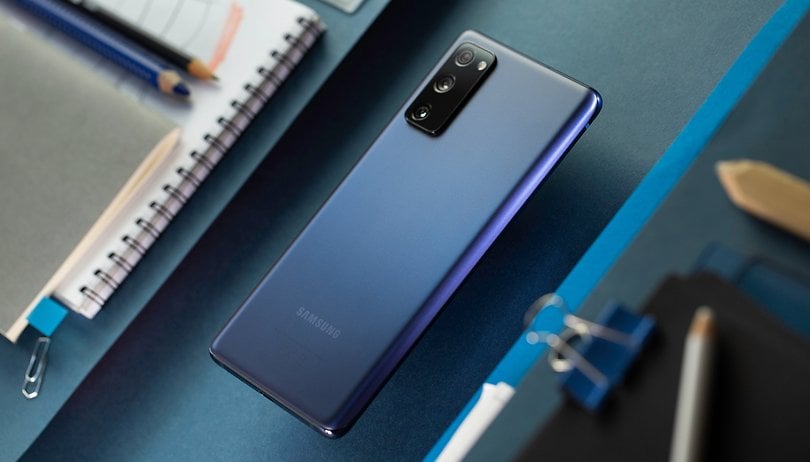

The Samsung Galaxy S20 FE was launched as a kind of farewell to the Galaxy S20 line, replacing the "Lite" suffix of the previous generation. The model obviously came with some compromises compared to the original model, supposedly catering to its "fans" - hence the Fan Edition moniker. We reviewed the 5G model that is powered by the Snapdragon 865 SoC in order to understand what this meant and show in this review whether the Galaxy S20 FE is still a good option to consider in 2021 if you are looking for a new smartphone.
Good
- 120Hz AMOLED display
- Snapdragon 865 SoC is still fast in 2021
- Good battery life
- Good quality plastic finish
- IP68 certification
- 3x optical zoom
Bad
- Not so fast charging
- No headphone jack
- 30x zoom is just a marketing gimmick

Samsung Galaxy S20 FE in a nutshell
At the end of 2020, Samsung resurrected the FE suffix which stands for "Fan Edition", which first appeared on the scene in the form of a reconditioned version of the hugely explosive Galaxy Note 7 as it sported a new, non-volatile battery. Rather than recycling a model with design issues, the Galaxy S20 FE brings together, in Samsung's own words, the best features of the S20 line at a more affordable price.
The S20 FE retains features such as the 120 Hz AMOLED display, under-screen fingerprint reader, a triple camera set up, water and dust resistance, wireless charging, and reverse charging.
On the other hand, you will have to miss out on the glass finish at the back with plastic replacing it, a lower screen resolution of 1080p from 1440p, 6 GB RAM and 8 GB RAM options depending on the model and region, and a telephoto camera with a lower resolution but making up for it with a 3x optical zoom.
The Galaxy S20 FE is an exercise in balance from Samsung, adopting a different strategy compared to the traditional Galaxy S range. Instead of offering a version with the Snapdragon processor in China and the US, leaving the Exynos SoC for the global model, the S20 FE 5G is powered by the Snapdragon 865 in all countries where it is sold.
- Also read: Samsung Galaxy S20 FE: Exynos vs Snapdragon?
The S20 FE (4G/LTE) model, meanwhile, was launched with the Exynos 990 processor, which is similar to the global Galaxy S20 in 2020, carrying the product code SM-G780F. But in 2021, it received a revision that had it powered by the Snapdragon 865 chipset in selected countries, and is identified by the SM-G780G product code which should the offer a degree of performance that is less susceptible to thermal throttling while offering even better battery life.
Controversies about the hardware specifications aside, the biggest selling point as highlighted by Samsung for the S20 FE 5G would be its price, having launched in Europe for $700 compared to the $1,000 asking price of the Galaxy S20 5G at launch. In 2021, the model can be found for approximately $600 across the old continent.
Design and screen: A familiar recipe
The launch of the Galaxy S21 line this year had one of the best designs we've seen in a Galaxy device to date. Launched just a few months earlier, the Galaxy S20 FE inherited the look of the S20 family which was released in early 2020, so the "Fan Edition" brings about a style that is already known but has become dated in 2021.
What I liked:
- 120 Hz AMOLED screen
- Plastic finish doesn't give a "cheap" appearance
- Good grip
- IP68 certification
What I disliked:
- Rear looks somewhat hollow at some point
- Camera bump is very noticeable
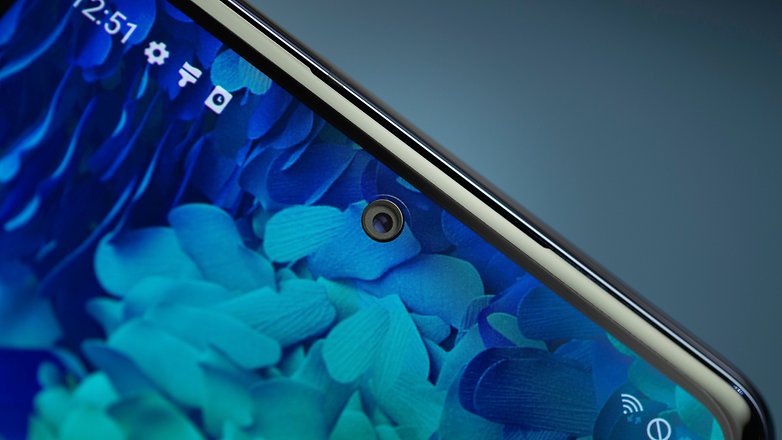
The device carries a more discreet look than the usual Galaxy S range, eschewing the recipe of a glass rear and curved screen that is hugely popular among Samsung's flagships. The Galaxy S20 FE sports a plastic back albeit one with good quality finish, which provides more firmness when you hold the device, although it is still susceptible to fingerprint.
The Galaxy S20 FE is equipped with a 6.5-inch AMOLED screen that doesn't extend all the way to the sides of the device, making it measure closer to the S20+ than the regular S20. Similarly, it tips the scales at 190 grams, which is closer to the 186g of the S20+ than the 163g of the base Galaxy S20.
The reduction in resolution which in the Galaxy S20/S20+ sports 1440 x 3200 pixels, to Full HD+ allowed the use of the 120 Hz refresh rate by default, with the native resolution of the original models reduced to just a 60 Hz refresh rate.
TL;DR: The Galaxy S20 FE's look may no longer be current, yet the minimalist and understated design seemed well suited to the device. The screen, on the other hand, made the right compromises, prioritizing a higher refresh rate over resolution.
Stable performance thanks to the Snapdragon 865 SoC
The Galaxy S20 FE 5G is powered by the Snapdragon 865 SoC, just like the new SM-G780G revision of the 4G model. It basically differentiates itself by including the Snapdragon X55 5G modem. The device was tested in the basic configuration, equipped with 6 GB of RAM and 128 GB of internal storage.
What I liked:
- Good performance for apps and games
- Stable operation even when gaming under a heavy load
- Faster storage than the Exynos model
What I disliked:
- -
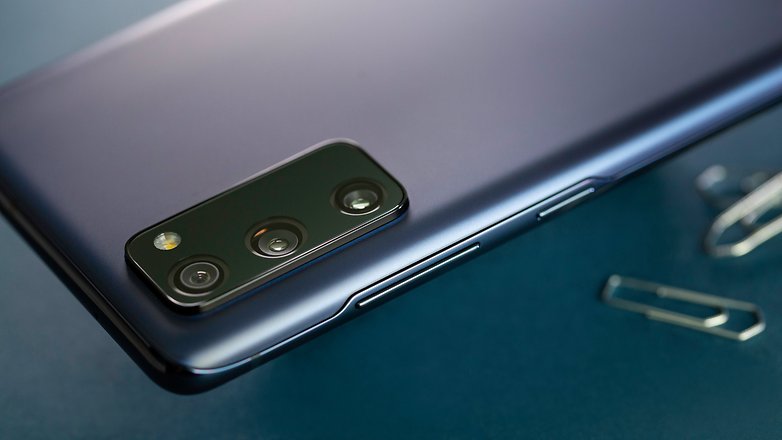
Remembering that the model was released in 2020, we can't expect performance levels that are up on par with those powered by the latest Snapdragon 888 or Exynos 2100 SoCs. Even so, the Snapdragon 865 is still a pretty competent processor in 2021, and no wonder that it was relaunched under the guise of its new name, the Snapdragon 870.
The launch of the Galaxy S20 FE 5G went against the tradition of Galaxy S models being equipped with Exynos processors only in Europe, displaying advantages in gaming performance and power consumption over the 4G model that is powered by the Exynos 990 chip.
Galaxy S20 FE benchmarks
| Galaxy S20 FE 5G (Snapdragon 865) |
Galaxy S20 FE 4G (Exynos 990) |
Vivo X60 Pro (Snapdragon 870) |
Realme GT (Snapdragon 888) |
|
|---|---|---|---|---|
| 3DMark Wild Life | 3.927 | 4.171 | 4.244 | 5.947 |
| 3DMark Wild Life Stress Test | 3.513 ~ 3.932 | 1.779 ~ 4.160 | 4.244 | 5.949 |
| Geekbench (single / multi) | 901 / 3.222 | 887 / 2.594 | 1.031 / 3.449 | 1.116 / 3.480 |
| PassMark RAM | 25.907 | 24.024 | 24.660 | 25.709 |
| PassMark Storage | 60.208 | 58.174 | 94.681 | 107.337 |
Even though it lags behind the new 2021 SoCs where gaming is concerned, the Snapdragon 865 is still more than capable for everyday tasks, as shown in GeekBench's multi-core and PassMark RAM scores. And even in the case of gaming, the Galaxy S20 FE 5G proved to be rather stable, with no major variations in the 3DMark Wild Life stress test, which simulates a long gaming session on the smartphone.
Unlike the Exynos model and some smartphones equipped with Snapdragon 888 in 2021, the Snapdragon 865 displayed a consistent performance not only in synthetic tests but also in real-life games such as Call of Duty Mobile, Free Fire and Real Racing 3, all with of the graphics settings being cranked to the maximum level and without experiencing any noticeable loss of frames.
TL;DR: The Galaxy S20 FE 5G was released with the best processor for Android at the time of its launch, and where it continues the current in 2021 of offering Bluetooth 5.0, Wi-Fi 6 and of course, 5G connectivity. Performance for everyday tasks should not be any less than this year's models, apart from some games that require more processing muscle at the highest graphics settings.
A versatile camera configuration
The Galaxy S20 FE brings a triple camera configuration that is similar to the one used in the Galaxy S20, but with a major change in the telephoto camera: The resolution is now at 8 megapixels (down from 64 MP), but on the other hand you get 3x magnification instead of 1.1x optical zoom.
What I liked:
- Good photos from the main camera
- 3x optical zoom
- Camera app offers a good default configuration
What I disliked:
- Inconsistent image processing between different sensors
- Camera island offers a considerable unevenness at the rear
- "Space zoom" only serves to inflate the specifications sheet
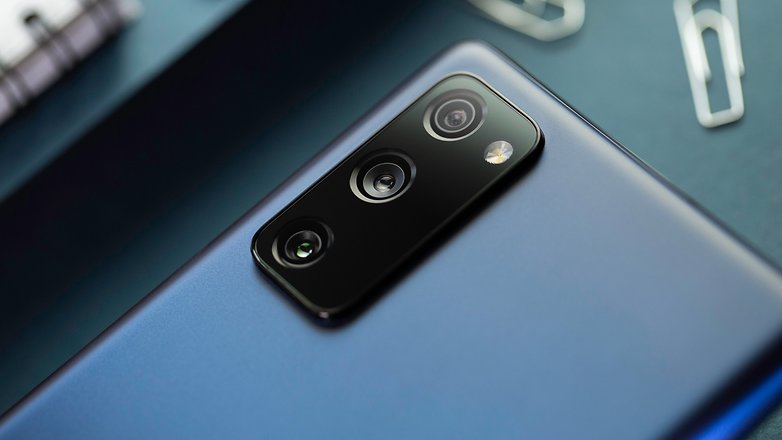
The main camera uses a 12-megapixel sensor, with specifications similar to the component found in the regular Galaxy S20, with 1.8 μm pixels and F1.8 aperture. The configuration is also similar to the one also adopted by the Galaxy S21, where it includes phase detection autofocus (PDAF) and optical image stabilization (OIS).
In bright daylight, photos from the wide-angle main lens follow Samsung's expected formula - offering saturated colors, especially with AI and HDR modes enabled.
12 MP main camera/ 12 MP ultra-wide-angle
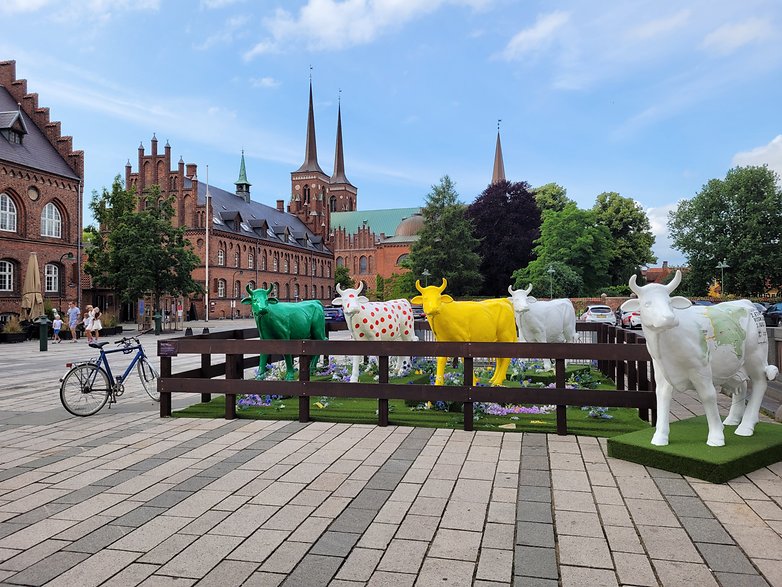 1x main lens 1x main lens |
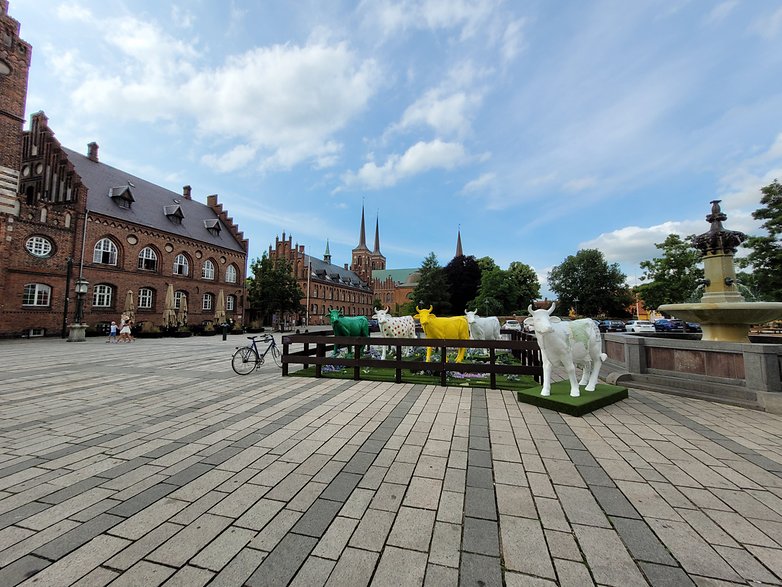 Ultrawide 0.5x lens Ultrawide 0.5x lens |
The ultrawide camera shots show rather different colors compared to those captured by the wide-angle lens, offering a more washed-out appearance. More serious than that, however, is the "blur" at the edges, while the center of the composition remains sharp, something that repeats itself in some photos. It is also possible to notice a slight chromatic aberration, also found in the corners of the image.
Ultrawide camera / main camera (1x and 2x)/ telephoto lens
 Ultrawide 0.5x Ultrawide 0.5x |
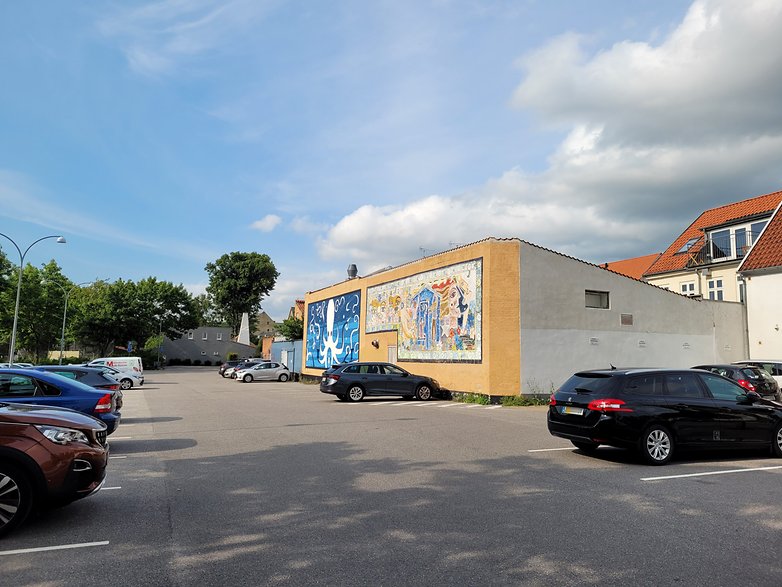 Main 1x Main 1x |
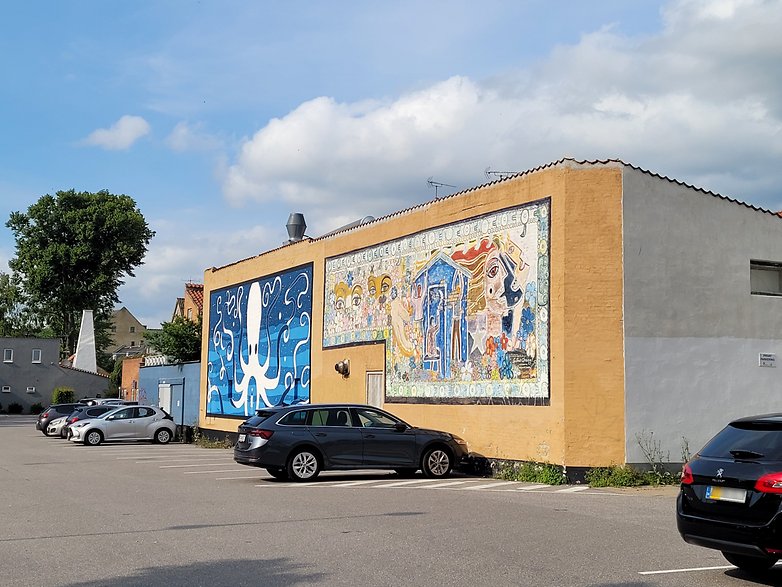 Main 2x Main 2x |
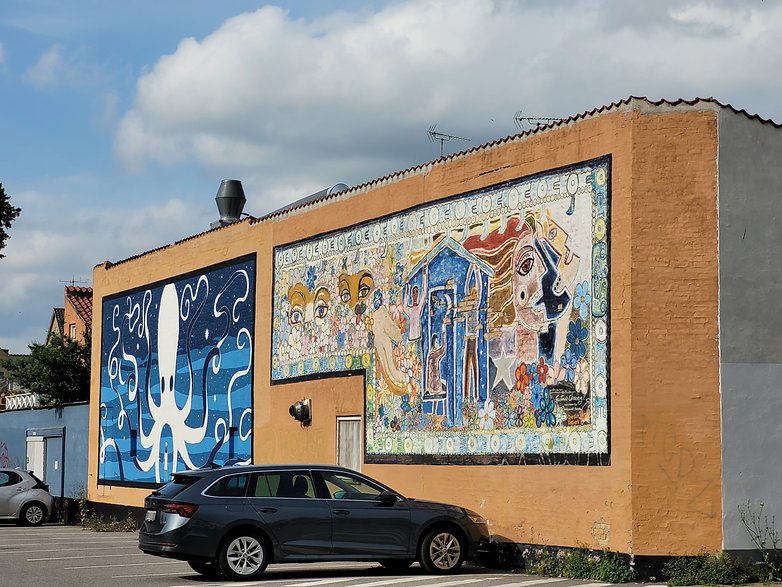 Telephoto 3x Telephoto 3x |
In another scene, the leaves on the tree again depict some blur in the ultrawide lens, which treats colors differently than the main camera. The 2x digital magnification still provides a good photo, but the telephoto camera shows the advantages of a 3x optical zoom, with additional details included.
Ultrawide/ main (1x and 2x)/ telephoto camera
 Ultrawide 0.5x Ultrawide 0.5x |
 Main 1x Main 1x |
 Main 2x Main 2x |
 Telephoto 3x Telephoto 3x |
Not to leave out the publicized "30x Space Zoom" that was highlighted in the Galaxy S20 FE's promotional material, I include two photos using the magnification level. As expected, the option serves more to inflate the specifications than offering any really practical photo results:
Space Zoom 30x
 Space zoom 30x Space zoom 30x |
 Space zoom 30x Space zoom 30x |
Night mode
 Main Main |
 Ultrawide Ultrawide |
 Ultrawide night mode Ultrawide night mode |
At night, the Galaxy S20 FE is no match for models such as those from the Pixel range, but it does deliver decent photos without over-processing to make it look like daylight or making light sources blurry in the scene.
Night mode is also available in the ultra wide-angle camera, but the processing does deliver a curious result when activated, where it seems that the camera app no longer applies any lens distortion for compensation, resulting in distorted objects in the corners, apart from the problem of the loss of sharpness that was perceived during the day.
Night Mode
 Main Main |
 Main Night Mode Main Night Mode |
 Ultrawide Ultrawide |
 Ultrawide night mode Ultrawide night mode |
In this scene, night mode improved the level of the image detail, but altered the color temperature of the main camera. As for the ultrawide camera, the result looks more like a brightness adjustment, with loss of details in the shop window as seen on the right, apart from the distortion problems that were mentioned above.
Selfies
 Selfie Selfie |
 Selfie with portrait mode Selfie with portrait mode |
Selfies offer natural color reproduction without any saturation from the main camera, or the excessive processing found in other devices. The portrait mode managed to deliver a good separation of planes for the bokeh, but it was a little aggressive when you take the face mask straps and some parts of the hair into consideration.
TL;DR: The Galaxy S20 FE's camera shots may not be among the best in the market, but they still offer good photos that can be shared on apps and social networks, and are decent enough even for some prints. The 3x optical zoom offers some variety of options even if it has a low resolution. Although Samsung insists on the so-called "Space Zoom", at least it should be commended for not giving in to the numbers race where resolution and the amount of cameras are concerned.
Excellent battery life but slow charging speed
The Galaxy S20 FE 5G is equipped with a 4,500 mAh battery, offering 25 W wired charging, 15 W wireless charging support, and 4.5 W of reverse charging capability. The review unit's packaging includes a 15 W wired charger.
What I liked:
- Great battery life
- Wireless charging support
- Reverse charging support
What I disliked:
- Not so fast charging speeds

Battery life under normal usage patterns that will include taking some photos, indulging in social networks from time to time, short gaming sessions here and there, attending to text messages and using maps to navigate - yielded more than 2 days' of use with about 20% of battery life remaining by the end of the second day. It's worth noting that the review was performed using a 4G-only data plan, and that 5G usage will most definitely impact overall battery life.
For this review, the Galaxy S20 FE still includes a battery charger in the box, but the charger is incapable of taking advantage of the phone's 25 W fast charging speed. In reality, a full charge will require around 1h 30m, which is an acceptable waiting time.
5 minutes of plugging it to a charger achieved 6-7% capacity, while 20 minutes was enough to achieve a 25% battery charge. With an hour plugged in, the Galaxy S20 FE 5G yielded between 65% and 75% capacity.
TL;DR: The Galaxy S20 FE's charger and charging time lags behind Chinese smartphones and their ever-increasing charging speed. Samsung does offer the unique proposition of wireless charging and also the practical reverse charging capability, which comes in handy to charge earbuds, smartwatches, and even other smartphones.
Specifications and other information
I have also listed other points that may be of interest to the NextPit community below, but are not worth any additional paragraphs:
- The Galaxy S20 FE includes NFC compatibility and is compatible with close payment systems.
- After resetting the updated handset, the system indicated 24.8 GB of used space right out of the box.
- The review unit came with a 15 W charger, charging cable and SIM tray opening tool.
- Software version RP1A.200720.012.G781BXXU3CUE3 (June 2021) was used during the review.
Specifications
| Samsung Galaxy S20 FE 5G | |
|---|---|
| Processor | Qualcomm Snapdragon 865 |
| Memory | 6/8 GB RAM 128/256 GB Expandable storage with microSD |
| Display | 6.5-inch, AMOLED 1080 x 2400 pixels (Full HD+) 120Hz |
| Camera | Wide-angle: 12 MP, 1/1.76'' sensor, 1.8 μm, F1.8, OIS Ultra-wide-angle: 12 MP, sensor 1/3'', 1.12 μm, F2.2, FOV 123º Telephoto: 8 MP, 1/4.5'' sensor, 1.0 μm, F2.4, 3x digital zoom Selfie: 32 MP, F2.2 |
| Battery | 4,500 mAh Wired charging up to 25 watts Up to 15-watt wireless charging 4.5-watt reverse charge 15 W charger included in package |
| Operating system | Android 10 Upgradeable to Android 11 with OneUI 3.1 |
| Connectivity | Wi-Fi 6 / Bluetooth 5.0 / NFC / 4G / 5G |
| Dimensions | 159.8 x 74.5 x 8.4 mm |
| Weight | 190 grams |
| Special features | Under-screen fingerprint sensor IP68 Certification |
| Colors | Cloud Navy, Cloud Lavender, Cloud Mint, Cloud Red, Cloud Orange, Cloud White (blue, pink, green, red, orange, white, availability depends on market) |
| Price | Around $600 |
Conclusion: Still a good option
The Samsung Galaxy S20 FE 5G is still a competitive smartphone that is worth considering in 2021. Despite more modern and faster models released this year, this smartphone "for the fans" is still an interesting proposition, depending on your budget and just how long you intend to keep the device.
Both performance and battery life are the main highlights of the model, which with the power saving modes such as reducing the screen resolution and refresh rate, allows you to enjoy up to 3 days' of use away from a power outlet depending on your usage pattern is certainly commendable.

In Europe, some 2021 models launched, such as the Poco F3 from Xiaomi, offer a better price-performance ratio than the Galaxy S20 FE 5G, and that would cost the South Korean model half a star in the ratings.
There are certain countries where the same Poco F3 would cost double the 4G version of the Galaxy S20 FE due to Samsung's aggressive pricing policy in selected countries, allowing it to share market space with models such as the Galaxy A72 and Redmi Note 10. If we were to take the 4G model of the Galaxy S20 FE into consideration, that handset deserves a 4.5 star rating due to its competitiveness in terms of price-performance.
Weighing in favor of the Galaxy S20 FE line is Samsung's update policy, offering up to four years of guaranteed security updates for the model, with three new versions of Android. That means you can even enjoy Android 13 on the Galaxy S20 FE as it is tipped to roll out by the end of 2022.
At this point, even the inclusion of a low-power charger seems like a welcome coincidence, as the additional time spent recharging the battery may extend the longevity of the device.
All in all, the Galaxy S20 FE has made the right compromises to arrive at a more affordable price range, giving up not-so-crucial features while delivering a balanced combination of performance, user experience, and longevity. The model is still an interesting option to pick up in 2021, especially if you can find one on sale. Looking back, it is not surprising that Samsung has repeated much of the same formula in the Galaxy S21 and S21+.



















